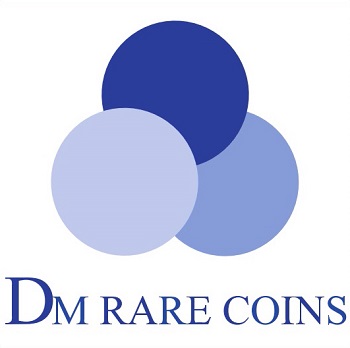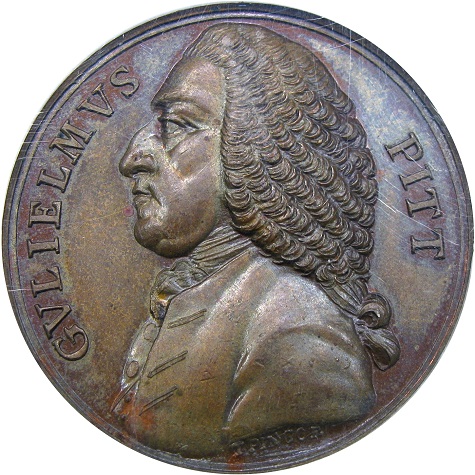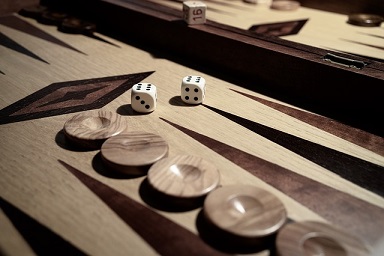Welcome to Our Blog!
Years 2020-2019
Find useful information, announcements, coupons, anecdotes, market reports, an educational Coin of the Month, and musings not suitable for our Research section.
December 31, 2020
DM Rare Coins Coin of the Month
December, 2020
A Real 1804 Dollar!
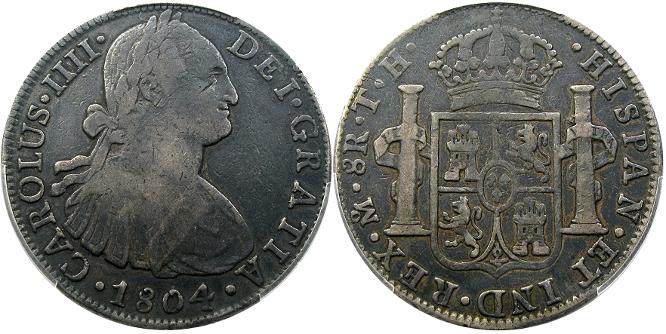
If you were expecting a Draped Bust dollar, you were mistaken. The so-called King of American Coins is a myth. Our coin of the month is a real 1804 dollar. It was made in the Americas in 1804, it circulated in early America in 1804, and it was dated 1804. No other supposed 1804 dollar meets those criteria.
The 1804 dollar was something of an enigma for many years. Mint records showed 19,000 struck in 1804, but no one had ever seen one. It turned out that, for reasons hard to understand today, the Mint was running behind on die production, and dollar dies were backdated by one year. The dollars struck in 1804 were dated 1803, the dollars of 1803 were dated 1802, and etc. Fast forward 30 years to 1834, when Andrew Jackson commissioned Proof sets to be sent out to dignitaries abroad. Silver dollar production had ceased after 1804, so there were no current dollar coins in include. Thus, new dollars were produced for the 1834 Proof sets, from new dies, using the last recorded year of production, 1804. Collector demand for an 1804 dollar was so strong following their 1834 production, that two rounds of restrikes were issued in the 1860s, from additional die pairs. In all, there are 3 types of 1804 Draped Bust dollars, and none of them have anything to do with the year 1804.
Furthermore, no one putting together a set of Draped Bust dollars need include an 1804, because those coins were Proofs anyway; they are not part of the circulation set. Including one of them in the business strike set, or feeling badly that you may never be able to finish the set because of the extreme price tag, is reminiscent of the strange desire of many individuals to include an 1895-P Morgan in their circulation set. That coin, too, is a Proof-only issue, yet it is frequently seen, erroneously, as a Morgan dollar series key by collectors who are not looking for Proofs. A complete set of circulating Draped Bust dollars simply does not include an 1804 Proof.
Spanish colonial 8 Real coins; aka, Spanish Dollars; aka, Pieces of 8; are as American as apple pie. As we mentioned in our October COTM post, Spanish silver was the engine of economic activity in the British colonies and early America, right up until 1857, when it was determined that the U.S could finally make enough coinage to meet its own demand. Spanish silver was ubiquitous in the early 1800. Not only would the founding fathers have readily recognized this 1804 dollar, but the Spanish dollar was the direct inspiration of the U.S. dollar and its subdivisions. And, the supply of Spanish dollars likely influenced the decision to cease production of U.S. dollars after 1804. America was not the only country to rely on Spanish dollars, either. Great Britain and her colonies around the globe used them, and famously, they became very important to China.
The present example, struck at the Mexico City Mint, as evidenced by the o/M mint mark near the denomination, is absolutely amazing for the grade. The surfaces are deeply toned and crusty original, unlike most survivors of this series, which are dipped, polished, or cleaned. These coins did take a beating around the world, after all, and seeing a well-circulated, originally toned, VF Spanish Colonial dollar with great eye appeal and minimal disturbances is a real treat, especially when it is areal 1804 dollar.
Happy Collecting!
Doug
DM Rare Coins
November 30, 2020
DM Rare Coins Coin of the Month
November, 2020
GEM 1963-D Franklin half dollar with accidental Reverse-Prooflike finish!
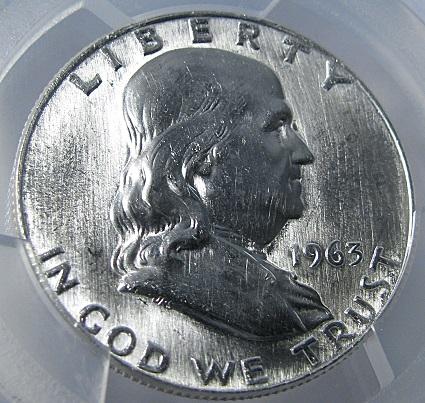
The normal finish for the Franklin half dollar is the satiny surface imparted upon die manufacture. Over time, that changes to heavy frost over the life of the die. In addition, many Franklin halves are seen with die polishing and filing lines in the fields because die clashing was frequent in this series, and mint workers were constantly trying to erase those egregious and sometimes comical ("Bugs Bunny") features from the dies. Sometimes this polishing was very aggressive, leaving long, parallel hairlines over the fields and devices of each side. This makes one wonder what the point was; the die polishing was certainly more distracting than whatever they were attempting to remove.
If die polishing is a common occurrence, our featured coin of the month is something very unusual. It's a 1963-D Franklin with such a weird finish that it can only be described as a Reverse Prooflike effect! Prooflike dies occasionally appear in this series, but we have never seen a Reverse Prooflike, until now. Unlike Prooflike coins, showing mirrored fields and frosty devices, a Reverse-Prooflike is simply the opposite, displaying mirrored devices and frosty fields. The already frosty fields of this die were heavily filed to remove clashing marks, making them even more matte finish, but the devices were largely untouched, and are glossy and somewhat reflective.
This is the first time we have encountered a Franklin, of any date, with such a finish. It is reminiscent of the Reverse-Prooflike Canadian silver Maple Leaf coins, which also show heavy die polishing in frosty fields, set against mirrored devices. In the case of this Franklin, the finish was clearly accidental, and the effect isn't 100% complete over both sides, but enough contrast exists to make this piece stand out as a real oddity. And, accidental makes it more unusual and rare. In other words, every Reverse Prooflike Maple Leaf has this finish, but how many Franklins have you seen with it?
This piece found its way into a PCGS MS65 slab, which is a feat for any brilliant 1963-D. Add in the Reverse Prooflike qualities, and you have a home run coin. Perhaps surprisingly, we acquired it for no additional premium. Unfortunately, PCGS does not offer any type of designation to show off this coin's oddly desirable features. That means there could be more of them out there, already certified, waiting for someone else to take the time to realize what they are seeing, and to snap it up. The slab label will not help you in this case. The search begins!
Happy collecting!
Doug
DM Rare Coins
October 31, 2020
DM Rare Coins Coin of the Month
October, 2020
1779 Lima Peru Mint Spanish Colonial 2 Real
Finest Known, as a VF35!
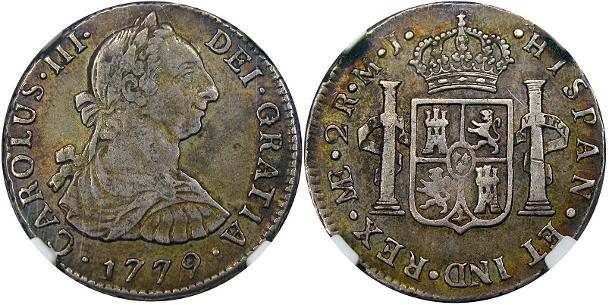
Spanish colonial silver is as American as apple pie. The mints near the silver mines of Central and South America produced the workhorse coins of commerce in the British colonies, thanks to the Kings’ refusals to allow British silver to circulate in America. Look up the economic system of “mercantilism” if you want to know why. Spanish silver coins filled the void and were commonplace in U.S. commerce, and legal tender until 1857.
The Mexico City mint generally struck the largest number of coins, and so, they are the most common today. Yet, there were also mints in Bolivia, Chile, Colombia, Guatemala, and Peru. These branch mint issues tend to be of a lower quality, in both strike and die preparation. Also, these mints generally struck far fewer coins, and the result is that these issues are typically much scarcer than their Mexico City counterparts. They also tend to look very different, with uneven strike, off-round planchets, numerous engraving errors, and weakness in fine details.
While a sizable number of Choice to Gem Mint State Spanish colonial issues exist, especially for the more common Mexico City mint issues, some dates are extremely rare, in any grade. Our featured Coin of the Month is a 1779 Lima Peru 2 Real, graded VF35 by NGC; currently the finest known example certified by either PCGS or NGC. The mint mark ME is found on the left reverse next to the pillar. A 2 Real is a quarter of the Spanish dollar (or 8 Real), and the direct forerunner of the U.S. 25 cent piece. In fact, the first U.S quarters were larger in diameter than they are today because they were made to be the same size as the Spanish 2 real. The U.S. quarter dollar was shrunken to its current size in 1831.
These branch mint Spanish colonials can be very difficult to grade. In fact, we take issue with the assigned grade of this piece, as the irregularities, typical of the branch mint issues, were not taken into account here. This piece shows just light wear over design elements and rims that remain quite crisp for VF, as well as a great deal of underlying luster in the fields and in the crevices of the portrait and other protected areas. This piece never had full details on the portrait of the pillars. If it had been struck at the Mexico City mint, it would have been rounder and sharper, and the details would look more like XF45, based on actual amount of wear present.
What no one can dispute, however, is the exceptional patina of this crusty original, finest known jewel! The frosty mint bloom in the fields illuminates the olive and apple green, russet orange, and gunmetal blue patina. No hairlines or other suggestions of past cleanings, or evidence of dipping can be detected. When considering that the vast majority of surviving examples of Spanish Colonial coinage are stripped brilliant and noticeably hairlined from cleaning and wiping, this piece really sticks out as the exception.
Ultimately, a coin of this unusual quality, and which is also the single finest known example of the particular mint and date, really is a home run find, especially at its recent auction price at under $150! If these details had been known to the collecting community, or even explained in the lackluster auction description, it probably would have sold for much more. There are surely more under-rated examples of Spanish colonial (aka Early American) coinage out there waiting for you to find, now that you know.
Happy Collecting!
Doug
DM Rare Coins
August 31, 2020
DM Rare Coins Coin of the Month
August, 2020
1833 Franklin & Montyon Bronze Medal with Great Color!
PCGS SP64BN
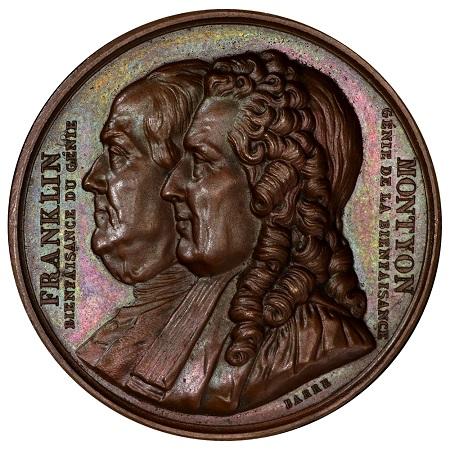
Our August COTM is a remarkably beautiful example of a fascinating medal devoted to Benjamin Franklin and his French counterpart during the Revolution, Montyon. The medals were dated 1833, engraved by the French engraver, Barre, and issued in conjunction with a book (Portraits de Histoire Des Hommes Utiles, Portraits and Histories of Useful Men) by the Society of Montyon & Franklin. The book listed and commemorated influential members of American and French society.
An unknown total mintage was completed with 4 separate die pairs, between 1833 and 1840, identified by Greenslet and Schenkman in The Medals of Franklin. Each is a Rarity-4, and each is similar, but they can be differentiated most easily by the positioning of the letters on the obverse, all of which were hand-punched into the dies. The present specimen is Greenslet-Schenkman 54, with F in FRANKLIN above EN, and Franklin's nose pointing to D.
This heavy, very high-relief bronze medal is typically plagued by friction, cleaning hairlines, rim bruises, verdigris or other corrosion, and spotting. The nicest examples tend to be deep, glossy brown in hue, and we have handled some very appealing pieces over the years. However, we have never seen this issue with exceptional multi-colored toning. The tell-tale chocolate brown patina seen on the nicest survivors is there, but when this piece is held in the light, the surfaces explode with dancing wisps of emerald green, magenta, rose, and sky blue color.
A truly magnificent example of this medal. PCGS has certified it to SP64BN and they do not differentiate between the four die pairs. This piece is tied with one other as the finest certified by PCGS. It blows the other 64 piece away in terms of eye appeal, based on the CoinFacts images. There are a few examples slabbed by NGC at MS65BN and MS66BN, but we have seen them and those pieces do not display outstanding colorful toning. What a remarkable find! Try to collect all four die pairs, but don't expect them to look like this.
click to enlarge
Bibliography
Greenslet, Phil W. Ed. David E Shenkman. The Medals of Franklin: A Catalog of Medals, Tokens, Medallions, and Plaques Issued in Honor of Franklin. Token and Medal Society, Inc. 1993. p28.
Happy Collecting!
Doug
DM Rare Coins
July 31, 2020
DM Rare Coins Coin of the Month
July, 2020
1998-P "Pharaoh Washington" Die Break!
Mint State
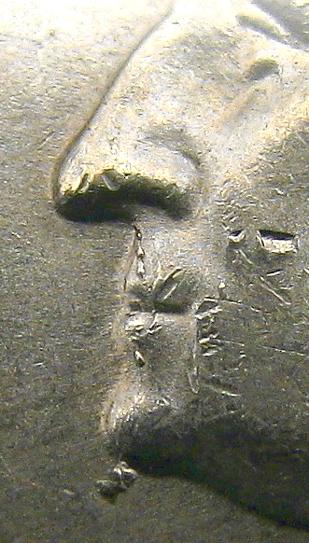
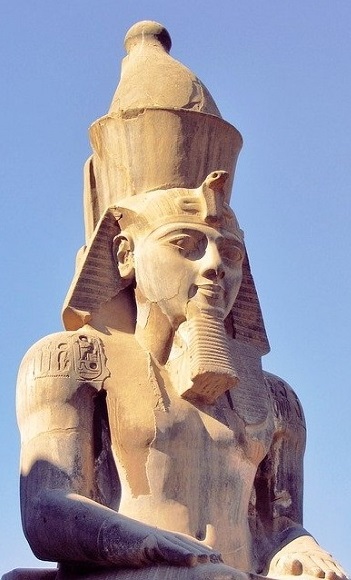
The designs of portraits of presidents that began to appear on U.S. coinage in the early 1900s are based on the Roman bust. One needs only to add a laurel wreath to Washington, Jefferson, Lincoln, Roosevelt, etc., and instantly you would have an emperor.
This month's featured COTM is a new twist on that concept; Washington's bust appears to be modeled after a Pharaoh of Egypt! A very clear column protrudes from the tip of Washington's chin as though he were wearing a postiche, or "false metal beard;" a familiar accessory for ancient Egyptian Pharaohs (Britannica).
This cool error is actually the result of a terminal die crack that meanders around and nearly bisects the obverse. Starting as a hairline break at the rim above the R in LIBERTY, the break cuts down through the R and into Washington's hair. From there, it travels down his forehead and the bridge of his nose, where it begins to widen into tear drop die chips as it travels across the lips, lacing shut Washington's mouth. At the chin, it expands into a large, textured die break, forming the postiche. Almost invisibly, it continues down through the W, popping up again on the S of IN GOD WE TRUST, as a large, round die chip inside the lower loop of the S. It leaves the S heading southeast but seems to vanish before arriving anywhere.
This obverse die would have been pulled out of service and destroyed the moment this terminal die break was discovered. The reverse die is perfect. It remains very rare, especially in Mint State, as however many pieces were released seem to have gone into circulation. A cool "die state variety," for which everyone should keep a watchful eye.
click to enlarge
Bibliography
Encyclopedia Britannica. 7/25/2020. https://www.britannica.com/topic/postiche
Happy Collecting!
Doug
DM Rare Coins
June 30, 2020
DM Rare Coins Coin of the Month
June, 2020
1951 Proof Jefferson Nickel Doubled Die Obverse FS-101
NGC PF67* Rare Cameo Obverse!
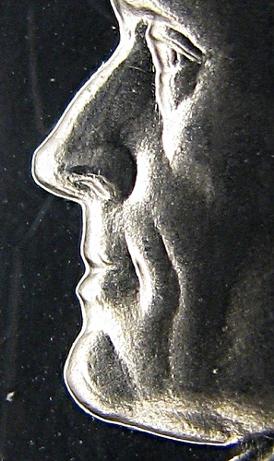
Our selection for Coin of the Month was an easy one in June. Not only does this 1951 Proof Jefferson nickel come in a rare grade, but the variety itself is an exceptional example of a Proof Doubled Die.
Most Doubled Dies in the Proof Jefferson nickel series seem to be minor DDRs, so a DDO variety piques my interest off the bat. But this one is truly special. Rather than a few split serifs or some extra thickness on select letters, this Doubled Die has strong spread on Jefferson’s profile; something not seen on this series; in addition to moderate to wide doubling on the lettering. Some of the doubling on the lettering was polished off during the die finishing process, but enough remains to make the point that this is a strong DDO.
This variety is fairly common; actually, the Mint used a limited number of dies during this period, and so it can be supposed that a fair number of 1951 nickels came from this die pair. What is interesting is the early die state, which shows a voluptuous, full Cameo obverse, and partial Cameo on the reverse, all set against perfect black mirrors. Fresh Proof dies like this will show a minimum of star bursting in their fields. Only a handful of coins have been certified with either a Cameo Obverse (NGC STAR) or a full Cameo designation.
NGC PF67 STAR: 4 , none finer
NGC PF67 CAM: 9, 3 finer
PCGS PF67 CAM: 1, none finer
PCGS PF67 DCAM: 1, none finer
Things like this can be snagged cheaply in today’s laze fare online auctions environment, where most auction houses don’t bother to focus their cameras, let alone write descriptions or provide close-ups of diagnostics. This trend causes the great varieties to get lost in the alphabet soup of mediocre varieties, which seem to exist in large quantities, pervading catalogs left and right. This leads to depressed selling prices for varieties across the board. A collector looking at a high-end auction house listing with no description would naturally think that “the 1951 DDO FS-101 must not be anything special, since the auction house isn’t even going to show me the doubling.” The reality is that their focus is completely on turnover and quantity, that they don’t care what it is they are selling, and that, if you know your stuff, you can find quality on your own.
Happy Collecting!
Doug
DM Rare Coins
May 31, 2020
DM Rare Coins Coin of the Month
May, 2020
1948-S Prooflike Obverse Lincoln Wheat Cent
Rare Bronze PL Issue!
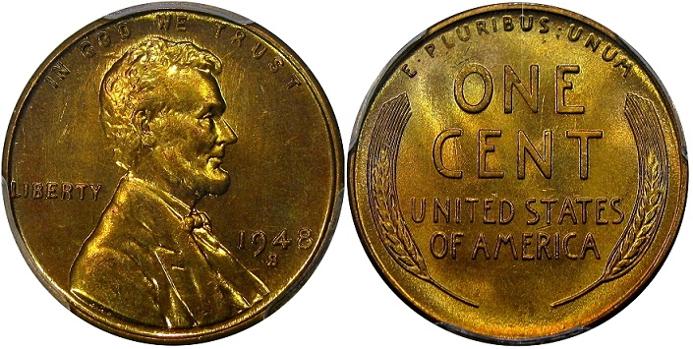
It's been a few years since we've revisited the subject of the extremely scarce Prooflike bronze cents, so this month's rare find is a nice opportunity to update the record. This 1948-S Wheat cent was struck with a fully Prooflike obverse die! In 2015, we handled the first Prooflike bronze cent ever certified (scroll back to the Coin of the Month we wrote on it). It was an amazing thing at the time, as there had been zero found, across all dates and types, until we came across a remarkable 1970-S that resembled a Proof. It also happened to be an important RPM die variety! Since that time, a handful more examples from various dates have been found and certified.
What is particularly interesting about this months featured coin, which makes it differ greatly from the 1970-S, is that it is from the 1934-1955 era, where the S and D mint Prooflikes were imparted with a granite-like texture, seen at some angles. We have done several articles on that subject, which would also be worth reviewing. The 1970-S has deep, smooth mirrors and closely resembles a modern Proof. The 1948-S obverse die is fully mirrored, but at a certain angle, shows heavy die lines and frosty striations running perpendicular to the lines.
In the five years since our 1970-S/S was graded, NGC has also identified a Prooflike 1888, a 1903, a 1908-S, a 1941-S, a 1968, a 1969-s, and 3 more 1970-S (two of which are the RPM). We have also seen some near misses, like this 1948-S with Prooflike obverse, a 1950-S that could have gone either way, and a 1955-S from a PL reverse die!
Prooflikes are becoming extremely popular, and expensive; and there are likely more of these to be found. The moral of the story is that there are opportunities out there, if you arm yourself with a little knowledge. No one had seen a PL bronze cent prior to 2015, but the newest coins were 45 years old at the time.
Happy Collecting!
Doug
DM Rare Coins
April 30, 2020
DM Rare Coins Coin of the Month
April, 2020
1829 British Historical Medal, BHM-1340
Francis Henry Egerton, 8th Earl of Bridgewater, NGC MS65BN!
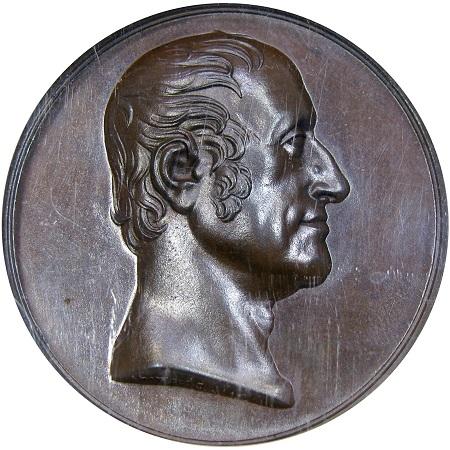
This exquisitely preserved piece was an easy choice for our April Coin of the Month. The typical example of this issue is plagued by corrosion or damage. The bust is very high relief; which lends to friction, scuffs, and weak strike; and the fields are plain and very susceptible to contact marks and hairlines. These pieces are quite heavy at 42mm and so thick it requires a double-thick NGC holder. One drop would result in considerable rim bruising. And yet, this piece is nearly pristine, on the verge of Prooflike, and has a razor sharply strike. The preservation is simply magnificent for an issue from 1829.
I know exactly what you’re thinking: “What the heck is this? I don’t know, or care, about British medals; and this seems kind of a random one, at that. No famous battles, no ornate engraving, and who is this Egerton guy?” Personally, I know a thing or two about British medals, and I felt the same way at first. You see these on eBay all the time in awful condition, and for less than $50. They look terrible and there is usually no description as to what they are. Besides, this type of stuff is what many U.S coin collectors in the past would call “Dark Side” material, largely due to the plethora of different World Coins to collect, and the lack of information available on them.
However, opinions on World Coins have been evolving in recent years; many classic U.S coins are just too expensive, and in the modern age, we have the luxury of the internet to get information. After coming across this extraordinary piece, I did a quick search on Egerton, and my opinion changed quickly.
A search will reveal several colorful web descriptions of Francis Henry Egerton, who was something of an eccentric, to say the least. A recent article from the UK, in the Hertfordshire Life, celebrated his 260th birthday. Viewing his portrait in the UK article and seeing how it compares to the portrait on the medal really makes the person holding this piece feel a connection. Egerton was a wealthy Englishman who hated France but decided, one day, that he wanted to live in Paris. He lived luxuriously in extravagance. His many dogs had servants, and Egerton demanded his dogs sit at the dinner table with him, wearing clothes, and to obey strict etiquette or face punishments. If he borrowed a book from someone, he returned it by horse and carriage with an escort. He once stood up to Napoleon’s regime, during the height of the Napoleonic Wars, and won. They were reorganizing the streets of Paris and his house happened to be in the way. He armed his servants and refused to leave. Egerton wore a new pair of shoes every day and saved them in order of use, and he could tell you what the weather was like on any given day by the mud on each pair. Despite his eccentricities and his “often surreal existence,” as the Hertfordshire Life described it, Egerton was highly educated and wrote over a dozen scientific books.
Upon his death on February 11, 1829, the Earldom of Bridgewater was dissolved. His will donated his papers and many original texts to the British Museum and other institutions. Also, these heavy bronze medals were struck to commemorate him. This gleaming, Mint State gem is the finest example known to survive. It could have been saved by a close friend or relative after his funeral, back in England. But it was bought for a song.
Bibliography
Hertfordshire Life, “The Irrepressible Francis Henry Egerton, 8th Earl of Bridgewater.” April 10, 2020. https://www.hertfordshirelife.co.uk/people/the-irrepressible-francis-henry-egerton-8th-earl-of-bridgewater-1-4772007
Wikipedia, Francis Henry Egerton. April 10, 2020. https://en.wikipedia.org/wiki/Francis_Egerton,_8th_Earl_of_Bridgewater
Happy Collecting!
Doug
DM RARE COINS
March 31, 2020
DM Rare Coins Coin of the Month
March, 2020
Discovery Piece 1907/1907 Re-punched Date Quarter Eagle
PCGS MS63 CAC ~ Green Gold!
Our Coin of the Month is quite an interesting little gold piece! Fresh from an old collection, it has never been cleaned in any way (not even some hand sanitizer :) and has that “green gold” hue that is so hard to find anymore. It is also a true Mint State piece, not a glorified, dipped out AU58, like so many of the gold anythings in 63 and 64 are today.
All of that is great, but also not why it was selected for Coin of the Month. That happened because it has a cool, fully re-punched date, 1907/1907. The 1 is widely re-engraved south of the first impression. While the next two digits show lesser re-cutting, the 7 shows two distinct serifs sandwiched together. There are several “RPDs” known for the 1907 Quarter Eagle, but this is not one of them! We submitted it to PCGS to get a generic RPD on the holder, as PCGS will recognizes unknown varieties using their "Minor Variety" label. NGC has taken the initiative to list the various dies for 1907 in their variety catalog, but they too are missing this one. There are none shown in the Cherrypicker’s Guide for 1907, either.
Ironically, the grade came back a touch on the conservative side. We probably would have done better at NGC, and could have gotten them to properly recognize this as a new variety in the process. I’m sure the graders weren’t used to seeing original,green gold. Oh well; we settled for a CAC sticker and a Coin of the Month feature to get this new variety on the record.
Happy Collecting!
Doug
DM Rare Coins
March 27, 2020
The Governor of Pennsylvania has placed our county under a shelter-in-place order, effective today. While we work remotely, there will be delays in shipping out some of our new orders. That said, we are still available for coin questions, and the best way to reserve a coin is to go ahead and place the order. We will update each buyer with shipping availability. Thank you for your patience during these unprecedented times! Stay in and stay safe!
Doug
DM Rare Coins
March 20, 2020
The following is an extract from our March, 2020 Email Newsletter, sent Tuesday March 17th. The only amendments I can add to it are as follows:
- PCGS has now closed, re-opened, and closed again since Tuesday.
- NGC has stated they will remain open through the pandemic, as they did at their China offices.
- PA businesses are in full lockdown at this time. We work remotely, so our operations are are not directly affected. However, there WILL be delays in shipping new orders, as great restrictions have been placed on banking access, and also, we want to contribute to efforts to reduce spread by staying in place and practicing social distancing.
Tuesday, March 17th
I will start the March newsletter by saying that this was not the market report I sat down to right on Monday morning. There are advantages to being an online seller during uncertain times like the present, such as adaptability. The Baltimore show has been canceled due to the current Coronavirus pandemic, and other shows are following suit. In Pennsylvania, the Governor has declared a State of Emergency and has asked all non-essential brick and mortars to shutter for the next 15 days, going along with the federal guidelines announced Monday afternoon. Many companies, if not closing down, are electing to work from home instead of gathering their employees together at the workplace. On the other hand, some online-only sellers, like us, are not seeing much of a change in our daily activities. We just aren't making any unnecessary trips out right now. (That said, it remains unclear what delays we may experience when shipping orders, going forward, should facilities be shut down in the area around us. This is a real possibility; in fact, we expect this to occur at some point soon. If that becomes an issue, we will post a notice on our website.)
For the coin market, in general: of course there are going to be temporary hits, due to cancellations and temporary layoffs taking place right now, across the economy. We are also hearing from collectors who have made the mistake of checking their 401Ks this week. However, in the long term and after the pandemic has subsided, many things should be bouncing back, and there will still be collectors waiting to fill the next hole in their collection.
The ultimate result of the current climate is that the collectors who were hoping to make purchases at the shows will, or have already, turned to online sources instead. Overall, the recent pandemic should only bolster the trend toward online coin transactions, which has been building over the past 15 years. Therefore, the current show closures should not be overly detrimental to the coin market, in and of themselves. Now, if the larger dealers could just get their pictures right, things would move even more in the online direction!
For dealers, who have coins siting in the vaults of PCGS and NGC waiting to be graded, it is a relief that the expert graders will actually be in-house in the coming weeks, instead of at the shows. That is still true if they are forced to close down temporarily (a very real concern at this point). It is always better to have the A-team there when your coins are going through the grading room. One drawback of show closures, from a dealer's perspective, is that coin shows are great sources for new material. Some dealers may start to lack in selection if they are not utilizing the internet fully.
Finally, I for one am leery of mailing non-essential, large shipments right now, so we have a lot of nice coins that have not been sent to CAC. I'm glad we got our NGC/PCGS submissions out when we did! When things clear up, we may have a hefty CAC submission to do, as I imagine other dealers will, as well.
Prior to this pandemic, the market had been moving along at a slow and steady pace, possibly with a slight uptick. I was actually outbid on many of the items I was after in major auctions over the last month. Or, I was met with spirited bidding and had to pay much more than expected to get some of the coins that I did win.
It remains to be seen how the pandemic is going to affect the market in the short-term. I'm sure it is going to be touch and go at times over the next 8 eight weeks or so. One caveat is that there is a general run on silver bullion right now, with silver down below $13. Generic silver eagles are trading at a $10 premium over melt, instead of the usual $3-$5 premium. I am staying away from those right now. Unless you can find silver at or near melt, which is hard to do, it is not a good buy right now in this panic-driven market.
The most important things for our customers to do right now are to stay in, stay safe, prepare for the worst, but hope for the best. Our thoughts are with all of you through this uncertain time!
February 29, 2020
DM Rare Coins Coin of the Month
February 2020
1766 William Pitt Stamp Act Repeal Medal
Rare 1863 New York City Counterfeit
Previously Unknown in Bronze! Choice Mint State
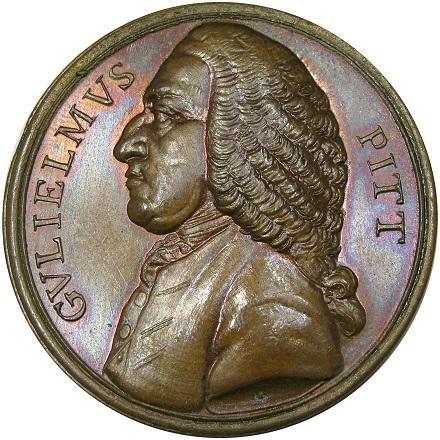
Our recent article, posted in December, 2019, requires an exciting update! As if by fate, one of the missing links discussed in the article turned up for sale online, just a month after we posted the article. Nowhere in modern auction records have we been able to document one of these, until now, and I have been closely following these for over a decade. Maybe we drew it out of hiding just by finally talking about it. My layman’s explanation of the “observer effect” of Quantum Theory says that outcomes can be changed simply because of our focus on them. Weird stuff!
The new discovery is an example of our Die Pair 4 in bronze, something that only had the hypothetical potential to exist, and thus, as a real life medal, is altogether new to our census. It is assumed to be extremely rare, and will receive an R8 rating when we update the article. Its newfound existence seems to satisfy a mystifying quote in Betts. He infamously references two variations of his Number 515 in bronze. Until now, we had only been able to document one.
Remarkably, the condition of the newly discovered piece is so nice that it is quite possibly the finest known example of Die Pair 4, in any metallic composition. It even has mint red remaining in places. The apparent trial strike in silver, shown in our article and compliments of Heritage, grades about XF45. The only other known pieces were miss-strikes; one being a flip-over double strike in a porous, white metal; and the other having been over-struck on a worn, British Charles II crown. All three of these previously known examples seem to be traceable to the Edward Groh account published in 1901, and all three were issued under special circumstances.
This new bronze piece seems to be the only normal example of Die Pair 4. Clearly, it is one of the pieces Groh speculated must surely have been made after his encounter in that clandestine, NYC shop in 1863. Its choice Mint State detail reveals new and important information about its manufacture, too. For instance, it was struck on a cast planchet, and some of the hair details were hand re-engraved into the crude copy die they manufactured to make the counterfeits. It is a remarkable find, and its pictures are shortly going to replace the current plate coin in our attribution guide.
For those not familiar with the varieties outlined in our article, Die Pair 4 is a proven 1863 New York City counterfeit of the original British medal that was struck in 1766, London. Please feel free to read all about it, and watch for the update to take affect this month!
Happy Collecting!
Doug
DM Rare Coins
January 31, 2020
DM Rare Coins Coin of the Month
January 2020
1964 NGC Proof-67 Washington Quarter
Outrageous Monster Florescent Toning!
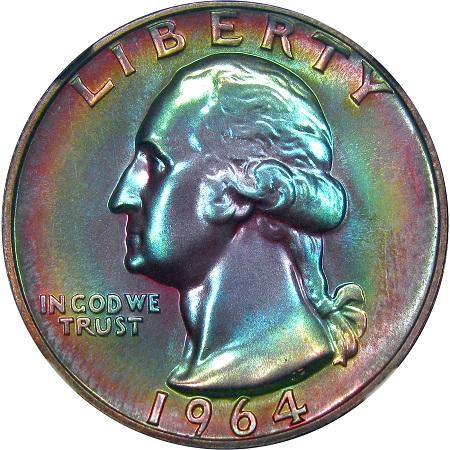
This is a crazy coin on many levels. Who would have thought a 1964 Proof would make our Coin of the Month list? But, when you are dealing with florescent, monster, concentric toning, and perfect surfaces, it very quickly becomes something truly special.
The Proof sets of the early 1960s will occasionally develop beautiful, outrageous color. However, it most often affects the nickels and cents. When silver is left alone in the Mint packaging long enough, it can also develop special hues. The fact is, most silver coins, due to their intrinsic value, were prematurely removed from their mint-issued cellophane and cardboard packaging, while the base metal nickels and cents were left behind and allowed to tone. This particular quarter probably stayed in that mint packaging. This is likely, not only because of the toning, but also because the delicate, mirrored surfaces are essentially pristine. It was probably laying flat, faced up, for many years, preventing oxidation of the central reverse. As a result, the reverse rims received more concentrated oxidation, causing deep brown swaths, with traces of iridescent russet and green hues under magnification. If the reverse had toned differently, this would have received the Star Designation for sure.
Normally, I will end these posts by telling you to go out and find a similar item for yourself; these are educational articles, after all. However, this one is not going to be easy to duplicate.
Happy Collecting!
Doug
DM Rare Coins
Posted 12/29/19
new article!
Our new, feature-length research article identifies four separate varieties of the 1766 William Pitt Stamp Act Repeal medal. The variations of this medal have not been properly cataloged, and confusion and misrepresentation have been the result. Don't get duped; read the article and see the attribution guide!
December 31, 2019
DM Rare Coins Coin of the Month
December 2019
1886-O Morgan Dollar Choice Original Poor-1 Lowball Grade
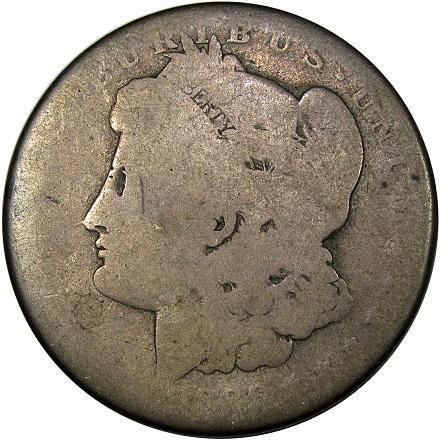
Registry sets tend to favor the richest collectors, who can afford to spend millions to get the best coins. That was the bottleneck that originally created the concept of Lowball Registry sets, where everyday collectors could compete for the lowest grading coins.
Morgan dollar collectors have especially taken to this concept, as most dates can be found, with some searching, in very low grades. Morgan dollars can even sometimes be found in Poor-1. As a general rule of thumb, a Poor-1 will be worn up into the design to the point where the date and mint mark are just barely discernible.
The wrinkle is getting the coin to certify as problem free. Most low-grade coins have damage, simply because they circulated for so long. Additionally, if wear has obliterated the date, the coin cannot be certified at all.
The piece that crossed my desk this month was a phenomenal example of a lowball Morgan. The wear is extreme, but the top of the date "1886" is there, and enough of the Mint mark "O" is clear. It should have no problem certifying at PCGS. In addition to extreme wear, it has rich, dark mauve gold and brown patina, probably from storage in a paper envelope. The crusty original surfaces are not that unlike the Seated quarter we featured last month, in fact.
While the point of lowball sets is that anyone can afford to participate, the demand for such coins has really skyrocketed prices. A Poor-1 Morgan can sell for a few hundred dollars in some cases. Fair-2 coins can realize a decent premium for scarce dates, whereas the same coin in G-4, or even AG-3, may be worth just a few dollars over melt.
Happy Collecting!
Doug
DM RARE COINS
November 30, 2019
DM Rare Coins Coin of the Month
November 2019
1876 / 1876 Misplaced Date Seated Quarter Rarity! FS-305
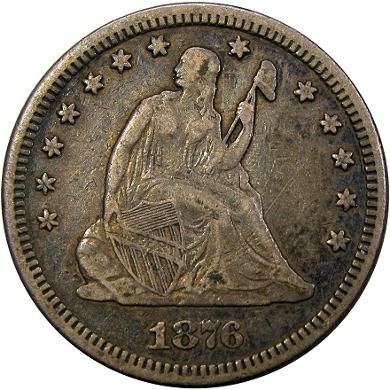
We have always found the varieties of the 1876 quarter to be fascinating; they are from a special year in Numismatics, and the multiple Misplaced Dates of that year are quite intriguing, as well. And, having contributed some of them to the latest Seated Liberty variety books and the CPG, we are always excited to offer one of them on the market. The Cherrypicker's Guide has now listed five varieties of the 1876. Our featured Coin of the Month for November is a gorgeously original Misplaced Date FS-305 that PCGS has graded VF35.
Remnants of all four digits can be seen below the primary date, hidden within the dentils. VF35 might not seem all that hot, but this grade gives it enough rim detail that the variety diagnostics are unaffected by the moderate wear. Lower grades will begin to loose the dentils, and the digits hidden within them, and this may account for the pronounced rarity of most of these varieties today. For instance, PCGS has only certified five examples of FS-305, in any grade. VF35 is not bad at all, in that case.
The quality of the present piece is absolutely exceptional for the issue. Seated coinage tends to be extremely unattractive due to cleaning, spotting, and especially dipping and re-toning. Conversely, this quarter seems 100% original with deep, crusty, brown gold patina over both sides. This is how I wish every Seated coin looked. I also wish I could find a (any) Seated dollar like this....forget about it!
Happy Collecting!
Doug
DM Rare Coins
October 31, 2019
DM Rare Coins Coin of the Month
October 2019
1961 Franklin Half Dollar
High-grade"Bugs Bunny" & Mint Error; Obverse Struck Thru!
Our Coin of the Month spot for October goes out to a very special Franklin half dollar, one that was apparently overlooked for many years by previous owners. At a recent show, I was examining a group of Franklin halves that had been put into stapled cardboard 2x2s by a collector who cherry-picked them out of original rolls, many years ago. The dealer had left them in the flips and priced them all based on general eye appeal, with only a rough estimation of their condition, "BU," or Brilliant Uncirculated. It was clear that this group had never been cherry-picked by the modern variety crowd; I saw, and passed over, a number of "Bugs Bunny" halves, mostly in lower MS grades. The $40s in grading fees does not justify the $50-$100 price tag for many of the common ones in today's market.
A 1961-P in MS64FBL with the Bugs Bunny clash is another story. FBLs are extremely scarce for this date, and the "Bugs Bunny" clash is also scarce. It is an intricate and delicate mouth clash that is very appealing in person, but very hard to photograph. The clash lines could not have lasted all that long on the die before star bursting die fatigue erased them completely. To make a long story short, 1961 FS-401 is very rare in MS64FBL. Going through this group of raw coins, I noticed this potential 1961 FS-401 right away, though it had spots and, through the dusty plastic, seemed to have damage or dirt on the obverse. I sat it aside until I was done. Going back through what I had set aside, I started dusting off the plastic window with my thumb, and realized there was another story behind this coin.
The anomaly in the right field was not damage or toning, but a rather huge strike-through Mint Error dent! This major Mint Error was most likely caused by a large chunk of hardened grease that fell onto the anvil obverse die and got stamped into the coin. Sometimes, a foreign object will actually stay on the die and strike multiple coins, leaving a similar impression on each, before falling off or even getting stuck on one of the coins and ejecting into the hopper. Every so often, you will see a coin with the struck-in debris still hanging on!
The dealer did not like this coin and did not appreciate the Mint Error, which I pointed out to him. He still thought it was an ugly, damaged, low-grade roll coin, and he wanted just $17.00 from me to take it off his hands. Not knowing its exact condition, I took a chance on it because of the strike-thru. I did not realize the extent of my spoils until I examined it under a grading light the next day. Out of the holder, this piece was an obvious score. It possesses a razor blade, FBL strike; the luster is fresh and bright; and only one small toning spot was actually on the coin. Most other haze and spots were on the old flip!
As a normal 1961-P Franklin, it was probably an $80 coin in MS64FBL, if certified. As a Mint Error piece, in MS64FBL, it was probably a $200-$300 coin. A 1961-P in MS64FBL with the "Bugs Bunny" FS-401 designation is a $600-$1000 coin, all depending on eye appeal, quality, and clash strength. The amazing bell lines certainly put this one into the high end of that range. Now, add together a "Bugs Bunny" designation on top of a Mint Error, and the coin goes into home run territory, easily earning our Coin of the Month spot for October. It is literally a unique piece.
The moral of this story is four-fold. A: You get really lucky once in a while. B: A little knowledge goes a long way. C: You can do this too. D: Take your coins out of the holder to examine them!
Happy Collecting!
Doug
DM Rare Coins
September 30, 2019
DM Rare Coins Coin of the Month
September 2019
1987 Silver American Eagle:
Beautiful Toning & Mint Error!
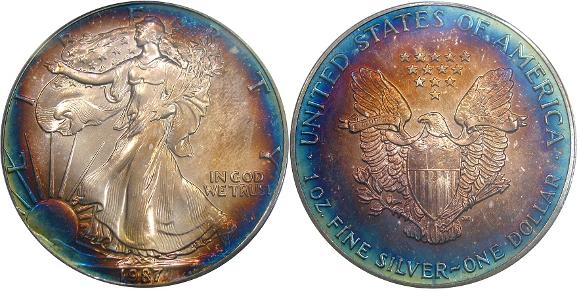
Our September Coin of the Month spot goes to a very interesting Silver Eagle we recently acquired. The ample amounts or iridescent toning and clean surfaces make for a gorgeous piece, but there is something else going on with this one. This magnificent looking, superb-gem coin is crowned by a cool Mint Error! A piece of thread found itself stuck between the planchet and the dies at the moment of striking, back in 1987. The long hair-like depression prominently runs across the reverse shield and turns left across the scroll.
But it’s the darnedest thing, PCGS did not label the Mint Error. This is a good time to explain how the grading process works. We do get questions, and sometimes complaints, from people who don’t see something written on the label, that we said was present on the coin.
This goes for die varieties and Mint Errors; if you submit a coin for grading and don’t pay the special fee for variety attribution or Mint Error service, your coin does not get reviewed for a variety or Mint Error, period. And further, many coins, particularly those in the 100-$300 range, are not worth the expense, or the hassle, of sending back to the grading service.
In this case, adding the words “Mint Error” to the label would require a $65 Mint Error grading fee; plus a $10 invoice fee; plus shipping both ways; and a 35-day grading time, not including the time it takes to get there and back. We simply are not going to send this back in, and there are other such examples from time to time. Usually, we will simply charge less money for the coin, and everybody wins! This is coin dealer Economics 101.
But as I was saying, Mint Errors do happen on Silver Eagles coins, on rare occasion. This piece combines a prominent Error with beautiful toning and a high grade. It has everything going for it, and it was an easy pick for September’s featured coin. It is also something you could find out there unattributed. Good luck getting color and a Mint Error together again.
(In an unusual twist on our educational blog, this piece actually remains available in our inventory, as of 9/30).
Happy Collecting!
Doug
DM Rare Coins
August 31, 2019
DM Rare Coins Coin of the Month
August 2019
A 1739 Admiral Vernon Porto Bello Taken Brass Medal,
of Particular Note, Crosses Our Desk!
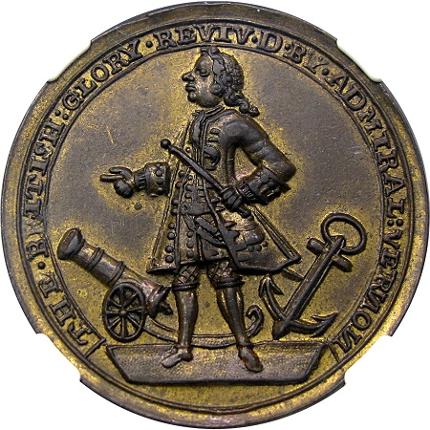
We have written various posts in the past about interesting Admiral Vernon medals we have come across in our studies and travels. Whenever we get one in stock, the first thing we do is look it up un the industry standard, Adams reference, both to identify the variety and to see how it compares to the Adams’s specimen.
For those not familiar with John W. Adam’s 2011 work, Medallic Portraits of Admiral Vernon: Medals Sometimes Lie, each catalog number is accompanied by a photograph and a reference to where the piece resided at the time the book was being put together. Almost all of the medals not in the possession of the British museum are listed as being in the private collection of John W. Adams. The medals in Adams’ collection tend to be just about the finest pieces known for their respective die varieties.
Thus, when we hold our pieces up to those in the book, it is always fun to compare the quality and to seeing just how our medal stacks up compared to the always impeccable Adams piece. Well, recently, we acquired an Admiral Vernon medal graded NGC MS63, a lofty grade for this series. Since they started keeping track around 2014, NGC has graded only 7 Vernon medals, of any type, in this grade or finer.
This magnificent piece is the finest certified example of Adam PBvi-6-G; that is, Porto Bello theme, Vernon portrait with icons in field, obverse 6, reverse G. Of the many, and I do mean many, PBvi varieties, this die is easy to attribute, being the only one to show an anchor and ship next to Vernon, rather than the typical cannon and ship, as seen on the many other dies. The noticeably high, wire rim is particularly fragile on this die pair, and it is amazing how nice it remains on this piece. The rims on these are typically banged up, with sections folded down or even broken away. Satiny luster catches the designs and lives in every nook and cranny of this nearly 300 year old, British American history relic.
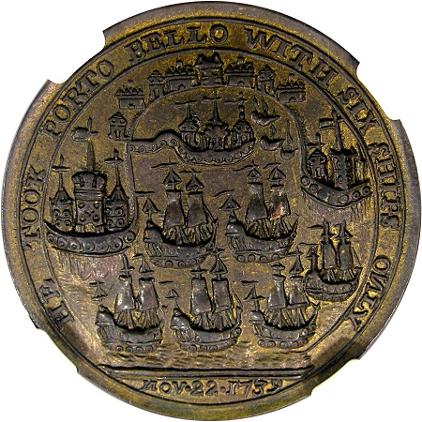
Knowing the variety, I did not look up the attribution until after the piece came in. As I finally sat down with the medal and the book, I knew, in the back of my mind, that I was about to give the Adam’s piece a run for its money. I opened the book to the page and began reading it over. I always start by reading the blurb underneath, to see if there are any peculiarities to look for. (Hey, this obverse was reused again in 1741 with a Carthagena reverse design.)
Then, as I started to examine the picture closely, I started to see similarities. Similarities turned out to be exact, uncanny features of the toning and patina. My medal did not just compare, I was clearly holding the Adam’s specimen in my hands! What a surprise this was! There had been no way to know; it was not pedigreed on the holder or anywhere else. (Did Adam’s sell his Vernon Medals? Who knows!) After the excitement wore off, I realized I still did not top an Adams medal. A tie is not a victory. I just can’t win; or maybe I should say, if you can’t beat ‘em, join ‘em?
Happy Collecting!
Doug
DM Rare Coins
July 31, 2019
DM Rare Coins Coin of the Month
July 2019
1892 Italian American Columbian Exposition Medal
Eglit-427, Newly Discovered Composition: Silver-plated Copper!
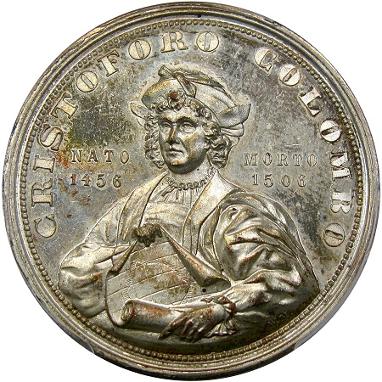
The wave of public enthusiasm created by the Columbian Exposition of 1892-1893, marking the 400th anniversary of the Columbus Expedition, has left lasting marks on virtually every aspect of the collectables community. Cigar boxes, pocket watches, clothing, shoes, pocket knives, and other trinkets can all be found with Columbian Exposition branding. In the numismatic department, hundreds of different medals are known to have been struck for the occasion, many of which were presented at the fair by various institutions. Some are covered under Hiblar and Kappen’s So-Called Dollars book, but that only deals with silver dollar-sized pieces. In fact, many different sizes and types were made, and a dedicated reference on Columbian medals is necessary to address all types. This demand was satisfied by Nathan Eglit’s work, Columbiana; The Medallic History of Christopher Columbus and the Columbian Exposition of 1893. Columbian medals not found in HK will be found in Eglit.
What many do not realize is that this wave of excitement also crossed the Atlantic; Italy celebrated the Columbian anniversary as well, and several medals were issued for the occasion, with Italian inscriptions for the Genoa Exposition. Artist Wilhelm Mayer engraved the most notable pieces, featuring similar themes to some of the American medals, which he also designed. Just smaller than a silver dollar, and not featured by Hibler and Kappen, perhaps the most well-proportioned and intricate of his medals is cataloged by Eglit as number 427. This high-relief Columbus bust is frosted and jumps out from richly mirrored, Prooflike fields, struck in dazzling, seemingly weightless Aluminum. On the reverse, the Italian arms of Genova hang over the rising sun, its frosted rays settling first upon the three ships sailing west, and then the statuary colonnade and the exposition building, about which many visitors can be seen strolling around. All of this is illuminated by gleaming, Prooflike fields. A very interesting and scarce piece, similar in style, and from the same artist, as the larger and more common American version, Eglit-55.
However, our July Coin of the Month spot goes not to a normal the Eglit-427, which was known to be struck in Aluminum, but to a rare variation, struck in silver-plated copper, and certified as such by PCGS. Silver is very similar in color to Aluminum, but the first give-away that something is different is that this one is substantially heavier than an a seemingly weightless Aluminum piece. Moreover, it is toned; the silver has developed some attractive, colorful patina that is simply not found on Aluminum. Also, the somewhat mottled surfaces are typical of a silvered copper composition. Eglit makes no mention of the existence of any composition, other than Aluminum, for this issue, and the featured piece is presently a unique discovery.
This delightful PCGS MS64 (graded before PCGS began using the Prooflike designation) is one heck of a find. If you are lucky enough to find any Eglit-427, ask yourself, is it weightless like Aluminum, or is it heavy?
Happy Collecting!
Doug
DM Rare Coins
June 30, 2019
DM Rare Coins Coin of the Month
June 2019
First DMPL Washington Quarters Ever Certified!
1998-D NGC MS65DPL
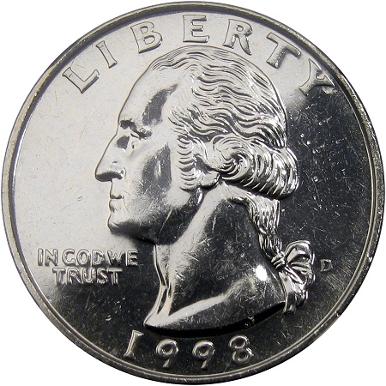
We continue the quest for surprises and oddities. The most recent on these is the discovery of a DMPL Washington quarter! Out of the entire run, from 1932 to 1998, there were no DMPL quarters known, until this month!
We have handled a number of “PL” 1998-D quarters; this final year of issue seems to have been given some special treatment by the Denver mint. As an aside, Philadelphia 1998 quarters are generally dull and repulsive, even in high grades. Actually, all the Denver denominations of 1998 are known in PL, and a few denominations have surfaced in DMPL, like our discovery 1998-D DPL Kennedy half dollar. Therefore, Denver was not giving the quarter any special treatment.
That said, we have not seen a level of reflectivity that would qualify a 1998-D quarter for the DPL designation until now. Where 1998-D PL coins are richly mirrored and fully reflective over medium to dark surfaces, the DPL piece beams like a headlight because the mirrors are so deep and fluttery, and the fields are jet black when looking head on. As we have said before about DPL coins, the surfaces look wet; it is as if there is an added dimension, a layer of water, sitting on the coin, held in place only by the surface tension.
This delicate luster of the DPL finish is distinctively different than a “PL” coin. It can only be the result one of the earliest strikes from a heavily polished die. Not all dies are even given this degree of shine when they were polished, so we are talking about the first strikes off an unusual die. Then, as that die continues to strike coins, tiny striations, called star-bursting, begin to develop in a radial pattern around the fields, and this quickly erodes the mirrors into frost.
As an example: on our discovery coin, the obverse mirrors are absolutely fresh and amazingly deep. However, the mirrors on the reverse are beginning to show just a trace of some striations, though not enough to affect the depth of reflection. The reverse still has that alive appearance, but you have to look just a little harder to see it, especially inside a slab. It is normal for the reverse die of a Washington quarter to wear faster than the obverse die, as there is so little field space, and the slightest erosion can quickly change the entire field. Many “PL” 1998-D quarters have developed too many striations, and the mirrors have diminished too much, to make DPL. This is also why so many Washington quarters get a Star and not a PL, the reverse often falls short of PL due to faster erosion.
It is feast of famine; two DPL 1998-D quarters are now on the books! Another coin appeared on the NGC population report the same day that ours was released! There could be a few more out there, so make sure you examine your 1998-D quarters closely. Remember, if you think you have a candidate for DPL, but you have to ask, then it is not DPL. You will know it when you see it. Sadly you cannot capture the look in a still photograph.
Happy Collecting!
Doug
DM Rare Coins
May 31, 2019
DM Rare Coins Coin of the Month
May 2019
1864 McClellan Sour Grapes Campaign Medal
Exceptional Eye Appeal and Mint Error!
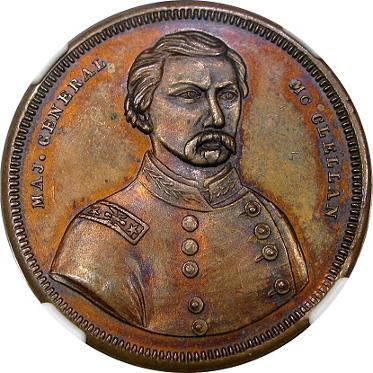
I remember watching the Ken Burns Civil War films on the History Channel, as a kid, in the early 1990s. One point I remember, that was found throughout much of the 9 part saga, is the idea that Major General McClellan was a major reason for the war dragging on so long. Whenever McClellan would have the upper hand, he would not press the enemy, instead he would stop; hemming, hawing, and waiting for Lincoln to send more troops. He made very few intentional advances, and began to garner a reputation for his methodically slow and overly cautious demeanor. Some thought him too cautious, others insisted he was vying for the White House in 1864, and wanted to keep both North and South happy with him.
Lincoln wanted rid of McClellan but had no one else. He replaced him briefly but had to bring him right back. Having second thoughts, he finally fired McClellan for good in late 1862, and there was no love lost. Today we know, from letters he sent to friends, that McClellan had been referring to Lincoln as a “baboon” from the start, and never intended to help Lincoln’s cause. And sure enough, he ran as a Democrat in the 1864 election so he could oppose Lincoln directly.
Recently, the entire Ken Burns Civil War documentary came out on Netflix, and it has been a fun time watching the old shows I saw as a kid, back when the History Channel aired historical materials. My recollection of the clash between Lincoln and McClellan had not been mis-remembered. I found the old photographs of McClellan particularly interesting, too, as I had just handled a piece of history from the 1864 election; a McClellan campaign medal, to be exact; and the high relief image on this Civil War relic is nothing short of eerie, when placed in context and juxtaposed against the old photographs of the general.
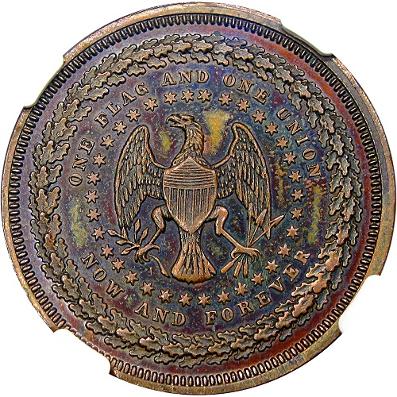
The knowledge of what this campaign medal represents, as well as the amazing condition of the piece, led to its selection as our May 2019 Coin of the Month. The handsome, high relief, lifelike portrait of “MAJ. GENERAL MC CLELLAN” positively jumps out of the obverse, aided some by the frosty cameo devices and the mirrored fields. “ONE FLAG AND ONE UNION: NOW AND FOREVER” is the inscription on the reverse, surrounding a version of the Great Seal of the United States. McClellan was definitely trying to unite the nation behind him, and he probably was all along.
The specimen in hand is a 2.5-3mm thick, heavy bronze piece with reflective fields, frosty devices, sparkles of red in the protected areas, no apparent marks, and the most delightful original patina one could imagine seeing on one of these. Iridescent colors line the original surfaces. Also of note is a sharp, curved clip at 4pm on the reverse. NGC labeled the Mint Error, but then cleverly concealed it under an extra-wide prong. Perhaps this was to preserve McClellan's legacy; it was entirely unlike him to cut corners.
Happy Collecting!
Doug
DM Rare Coins
Bibliography
"The Civil War: A Film By Ken Burns." Florentine Films, 1990. Netflix.com
April 30, 2019
DM Rare Coins Coin of the Month
April 2019
Wooden Luster: Possibly Unique Queen Anne "Medal" Struck on Wood.
1704 MI-269-69 Gibraltar Taken
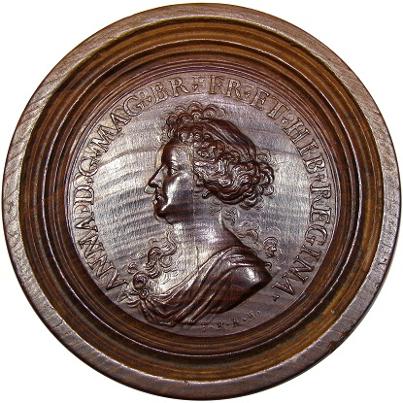
The German medalist Philipp Heinrich Muller is remembered for his metallic portraits, produced in Nuremberg, in the late 17th and early 18th Century. Most well-known are the medals depicting British themes, such as victories of William, 1689-1702, and Queen Anne, 1702-1714. His Queen Anne portraits have a unique style that separates them from the medals of the prominent British engraver of the period, John Crocker.
The diversity of all medals, in general, under the reign of Queen Anne is impressive, largely due to the many victories England enjoyed in the War of Spanish Succession. More specifically, Queen Anne had interjected Britain into a greater conflict by targeting France in 1702, creating Queen Anne’s War, but I digress. Silver was the primary composition for these medals, and the silver versions are extremely hard to find in mint condition, and rarely grade above MS63. Surprisingly, many bronze pieces from Queen Anne have survived in magnificent condition. It is not entirely uncommon to see them certified as high as MS65 and MS66.
What really surprised us was the appearance of this piece, struck not on silver or bronze, but into a carefully prepared disk of wood. One can see the lathe lines where the wood was carefully planed before striking. The medal commemorates the capture of Gibraltar and other victories and is Medallic Illustrations 269-69. The obverse is Muller’s portrait, but the reverse is technically unsigned. The edge of the original medal was signed by Friederich Kleinert, but there is no edge lettering on this 12mm thick, wooden version. The wood is likely black walnut, which was popular for its density. The strike is crisp and bold, and the wood has taken on the design with stunning exactness, despite the wood grain texture. The medal is noticeably double-struck, a circumstance often encountered on Queen Anne medals.
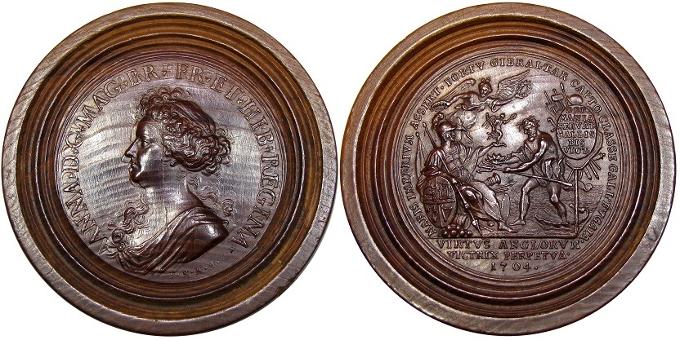
The fields of this jewel are imparted with actual luster, wooden luster, transferred over from the surface of the dies. This can make the observer forget they are looking at a piece of wood. The obverse is actually close to Prooflike, with noticeable mirrored reflectivity. The reverse is more of a satin finish. It is likely that the obverse die was polished to remove imperfections, or to minimize the effects of a long, thin die crack almost bisecting the die.
More impressive than the composition is the quality. The medal looks as though it were struck yesterday. The surfaces are seemingly pristine, not even a tiny tick to be found. There are no signs of handling at all, other than a few tiny chips at the outer margin of the larger disk, far away from the die face of this 58mm piece. A small item of this age and fragility does not typically survive so nice. One leaky roof, village fire, estate sale, flood, or carriage crash, and this piece would have been lost or ruined by moisture. Again, this is a fragile slice of wood from circa 1704.
The real question on everyone’s mind now is, why wood? There is a simple reason for this. While this piece is die struck, with Muller’s original medal dies, it was never actually intended to be a medal, per say. It had a much more practical purpose. This was a game piece, or "draughtsman," made for use on an early 18th Century backgammon table. With some digging, we have found just a few rare instances of these wooden, die-struck disks coming up for auction, over the past two decades. They are never in good condition, always showing mold, chips, cracks, wear, stains, and the like. Yet they seem to reach very healthy prices because of their pronounced rarity.
From the admittedly small surviving sample, which is of many different types, we can surmise the likelihood that sets of these were issued, representing numerous Kings, Queens, and battles of 17th and early 18th Century Europe. The Gibraltar medal was part of a larger series issued by Kleinert, in fact, and it is probable that all of those medals were represented in the game pieces (MI,269). The Gibraltar obverse die was cracked, almost in half, when this piece was struck, suggesting it was either at the end of its useful life or had already been retired from service. Perhaps the backgammon sets were issued after the entire medal series was completed. These sets would have been sold to the aristocracy of the day, but it is likely that an entire set does not survive today, and the exact number and nature of the pieces may be unknown. These disks were made to be used, not saved.
This set would have been expensive to make, as well as to acquire, and not many would have been produced. Plus, for the reasons of attrition already speculated about, far fewer would have survived the next 300 years. Indeed, the present piece is by far the nicest example about which we have seen or heard. It is the only piece we have seen that could be described as Uncirculated, and it is probably gem quality, as well. We have seen no other examples featuring this specific design, so it could potentially be a unique piece. It was intended to be played with, but instead, this one was clearly tucked away. Heritage described it as “an enigmatic piece,” which more or less sums up everything we just said, in three words.
Happy Collecting!
Doug
DM Rare Coins
Bibliography
Medallic Illustrations of the History of Great Britain And Ireland to the Death of George II. Vol. I. Ed. Edward Hawkins, Augustus W. Franks, Herbert Grueber. London; Longmans and Company, 1885 (p. 269).
Interesting MET video on youtube: https://www.youtube.com/watch?v=XVC9HOSwHl4
March 31, 2019
DM Rare Coins Coin of the Month
March 2019
Newly Listed 1959 Die Clash, Unlike Any Other Variety!
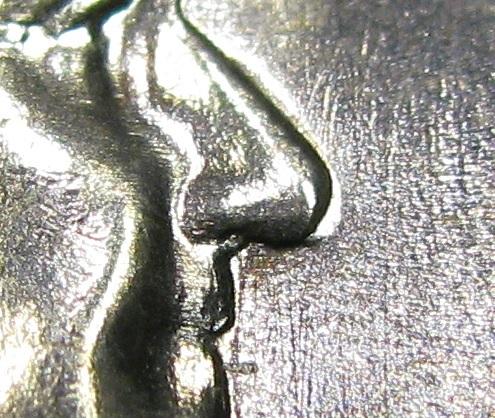
Our March Coin of the Month spot goes to a unique Franklin half dollar die clash that PCGS is now recognizing, at least as a minor variety. Not only is this an unusual die clash, but the die variety also happens to be a Type 2, retired Proof die pair, which is only found on a few dies in the series.
We have done extensive research into the die clashes found on Franklin half dollars. Virtually every date and mint is now known with some type of “Bugs Bunny” FS-401 or similar clash marks on, or near, Franklin’s mouth. Some dates are known with multiple die pairs with clashing. Indeed, die clashing is ubiquitous on Franklin half dollars.
That said, the present variety shows a die clash unlike any other in the series; that’s why it is so unusual. Instead of spikes or "teeth" around Franklin’s mouth, this die shows semi-circular die lumps at the junction of the lip and nose, as well as around the end of the nose. We have seen this pattern of die clashing on no other Franklin variety. That said, it shows the typical horn shaped clash near Franklin's neck, and the bulge beneath the eagle’s left-facing wing, proving that it is indeed a die clash. It reminds us of the 1943-S Goiter FS-401 Washington Quarter; which shows an abnormal bulge, from die clashing, that resembled no other clash date in that series.
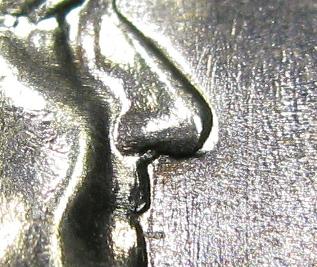
A possible explanation for this Franklin variety is that the dies used are actually of the Type 2, retired Proof design, and not those typically used for circulation. The resulting obverse die clash on this Type 2 variety still hits in the same places as on regular, Type 1 varieties, but the differences in the relief and fine details of the eagle probably lead to differences in the shape and appearance of the clash. Across the series, only a few proof dies were used for circulation strikes, and this only happened in 1958 and 1959. Thus, the scarcity of Type 2 business strikes makes general knowledge of their resulting varieties scant.
Also of interest, this variety shows a series of long, straight die lines that run up and down the obverse center, which add even more curiosity to an already fascinating variety. The Mint had very low quality control standards in this decade. Additionally, this retired Proof die pair developed a die break on the eagle' wing, right where the edge of Franklin's nose clashed with it, weakening the die steel. The short crack starts as a tiny round die chip at that same spot, between the feathers, and makes its way across the field and into the side of the bell.
This variety has actually been known and sought by specialists for about a decade, but has never been added to variety catalogues. We have recently submitted two of these to PCGS, and they, in turn, have agreed to label them as Obverse Die Clash, with the Minor Variety label; “minor” only because this variety is not in the Cherrypicker’s Guide. This is a great step forward for a cool variety, as this is its first formal acknowledgement. What other oddities are out there waiting for you to find?
Happy Collecting!
Doug
DM RARE COINS
March 20, 2019
We just received an award for our 2018 newsletter!

For the third consecutive year, DM Rare Coins Email Newsletter has been named an All Star Award winner by Constant Contact, a leader in small business marketing solutions. The annual award recognizes the most successful 10 percent of Constant Contact’s customer base, based on their significant achievements using email marketing to engage their customer base and drive results for their organization during the prior year.
A Special Thank You goes out to our subscribers for reading and responding to our emails! We cannot keep up with all the coins, information, and research without your support!
Doug
DM Rare Coins
February 28, 2019
DM Rare Coins Coin of the Month
February 2019
DISCOVERY PIECE: 1953-D Re-engraved Nose Franklin Half Dollar
Occurring with an Obverse Die Clash Fs-402 Die
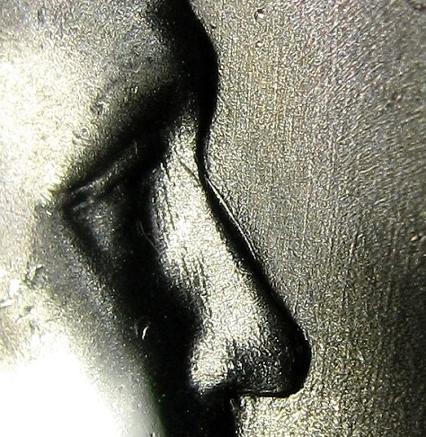
The 1950s were a barbaric time at the U.S. Mint. Pressure to do more with less, in the decade following the Second World War, lead to various cost saving measures with dies. In the 1950s, we see Proof dies reused to make circulation coinage, despite differences in design. We also see a number of re-engraved dies, mostly between 1944 and 1959. Once clashing has damaged a die pair, it is normal to polish the dies to remove traces of the mirror image. However, aggressive die polishing sometimes removes important design features, like the profile of Franklin’s bust. And, on rare occasions, mint workers will actually pick up a tool and hand engrave lost details back into a die. In fact, our February Coin of the Month spot goes to a new Discover Piece which we just sold, a 1953-D Franklin Half Dollar with a Re-engraved Nose!
The coin is certified by PCGS as the popular Obverse Die Clash FS-402 variety, which indicates a type of “Bugs Bunny” clash under the nose. There are multiple 1953-D dies that developed similar clashes, and we have seen them all. What we have never before seen is this die, in this specific stage, where it is absolutely apparent that someone tried to strengthen or straighten the bridge of Franklin’s nose, following a die clash.
Franklin half dollar clash varieties will often show a spike running perpendicularly through the bridge of Franklin’s nose, creating a bump. This is actually the right edge of the bell transposed onto the obverse. Conversely, the reverse die, on one of these clash varieties, will typically show an outline of Franklin’s nose running into the bell. Usually, the Mint workers will polish the fields around the profile and bell in an attempt to remove various clash marks. In this case, they went a step further and cut a new bridge into Franklin’s nose. Ordering a new die would have been an unthinkable expense when the fix was so easy!
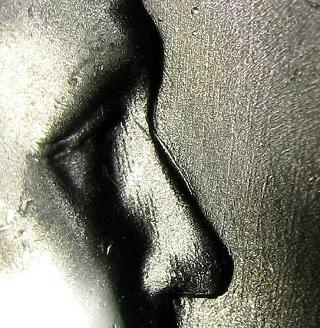
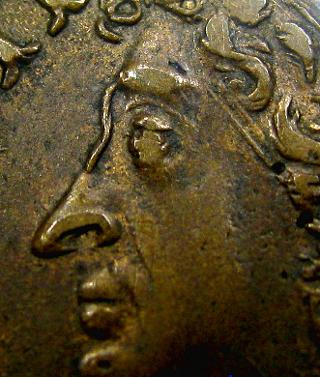
1953-D Re-Engraved Nose Franklin Half vs. 1689 Re-Engraved Nose Gunmoney Shilling
This new 1953-D Franklin variety hearkens back to a centuries-old coin we recently handled. During James II revolt against the Accession of William and Mary in 1689, James fled to Ireland and raised armies that were to be paid with tokens, supposedly struck from melted bronze cannons. These so-called “Gunmoney” tokens are very crude, as they were made out of shear desperation, leading up to the sound defeat of James in 1690. The well-worn dies of this piece suffered an atrocious, cost-saving measure when James’ portrait was partially re-engraved with a new profile, by an overzealous mint worker who was trying to breath new light into the dies. This is remarkably similar to what happened in 1953, but under much less dire circumstances.
Happy Collecting!
Doug
DM Rare Coins
January 31, 2019
DM Rare Coins Coin of the Month
January 2019
Elusive and Unexplained 2005-D Cameo Prooflike Roosevelt Dime
From a"Satin Finish" Mint Set. NGC MS69 PL SMS
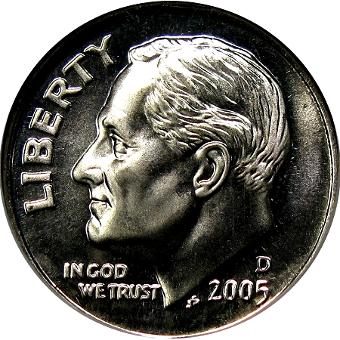
The Mint seems to have great trouble making a consistent product from year to year. That is not intended as a criticism; if they did not have strange anomalies in their coinage production from time to time, some of the hobby's great varieties, errors, and even Prooflikes would not exist. One such happy aberration occurred in 2005 and is highly desirable, though not well-understood. Between 2005 and 2010, the annual Uncirculated Sets issued by the Mint; something collectors have long known as Mint Sets; were struck in a new, “Satin Finish.” Instead of the metallic sheen of the normal, clad business strike, the Satin Finish was supposed to be a thick coating of heavy frost covering each side, which was to give each coin a uniform, non-reflective texture. PCGS simply labels these as “Satin Finish,” while NGC calls them “SMS” for Special Mint Set. Interestingly, some of the dimes struck in Denver show something completely unintended, mirrored fields and Cameo frost over the devices. These coins do not match the uniform finish intended by the Mint, and they should not exist.
The purpose of the Mint Set is to provide a way for collectors to easily obtain one example of each circulation-strike coin made in a given year. Thus, it is unclear, in the first place, why the Mint ever decided to change these coins to a Satin Finish. Instead of a convenience, they made it more difficult to obtain circulation strikes. Nevertheless, and for unknown reasons, they did it. However not all of the 2005 Satin Finish coins where satiny, as planned. A handful of 2005-D dime dies were made with beautiful, Prooflike qualities. The finish on the affected coins is very inconsistent. Some have partially mirrored surfaces over each side, a Prooflike obverse, or even fully Prooflike fields and frosted, Cameo devices. Since their release, NGC has issued Star designations to many of these, and to a select few, actual PL designations, and at least one Cameo! All of this is highly unusual for an issue that is supposed to be Satin Finish. We have often wondered if it was the existence of these Prooflike coins that caused NGC to use a more general SMS designation for these sets, instead of the Mint’s “Satin Finish” label.
The distribution of these hybrid pieces was as inconsistent as the dies themselves. These unusual coins were randomly mixed into the sets along with normal, 100% satiny pieces, and only the dimes were affected. They emerged early during the 2005 Mint Set release, and some collectors who heard about these Prooflike dimes ordered extra sets in hopes of finding some for themselves, although, the Prooflike concept was still in its infancy in 2005.
Having been fans of PL coinage for a very long time, we were hot on the trail for these in 2005. Yet, I never did find one. The subject had faded away into a distant memory, until very recently, when we came across our featured Coin of the Month. This NGC MS69 SMS PL dime is among the finest known examples of the SMS PL phenomenon. Just 48 of the 2005-D SMS dimes have made PL in all grades, including just 14 in this finest known grade. Curiously, despite these going as high as MS69 PL, none of the PL Satin Finish coins have been certified with the Full Torch designation. Could this be a potential clue to their origin?
What are the likely causes of this decidedly odd PL finish? I always assumed that the Mint was merely experimenting when they introduced the new Satin Finish, and that not all the dies were prepared consistently. At a glance, it seems as if the Satin Finish was only applied to the design elements, while the fields were polished to a mirrored surface. The Satin Finish continued for another four years, ending with the Mint Sets of 2010, but never again was this amazing PL effect seen. It could be that Mint figured out the process by 2006. Then again, it only happened on a handful of dimes from one mint, and no one is sure how many dies were involved.
Another possibility is that the dies were prepared with full satin and then polished to remove defects (the common origin of many PL coins). If a Mint worker polished the fields to remove a clash or a spur, but failed to reintroduce a Satin Finish to the fields, you would be left with the same randomly frosty devices and mirrored fields as are seen here. This could have taken place either before or after the dies were placed into use. Further, the incomplete detail on the lower torch, which has prevented FT on every PL piece certified, suggests that the lower bands may have been compromised on the dies themselves. The exact answer would require an examination of a number of pieces in various stages, though these are few and far between.
Needless to say, we were very pleased to handle the featured example. It was a real throwback to Mint Set searching we did in 2005. It is also a reminder of the fun of going through sets, of the surprises that the Mint can throw at you, and even the letdown of not finding one of these at the time. I don't think I found anything in MS69 either. Maybe I should keep looking!
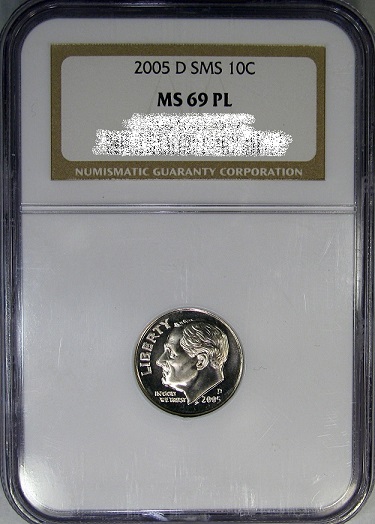
Happy Collecting!
Doug
